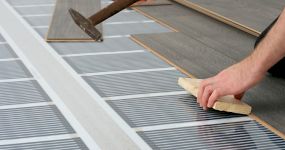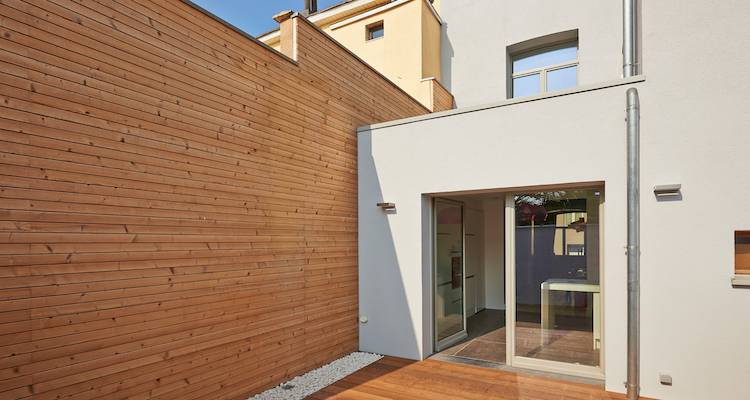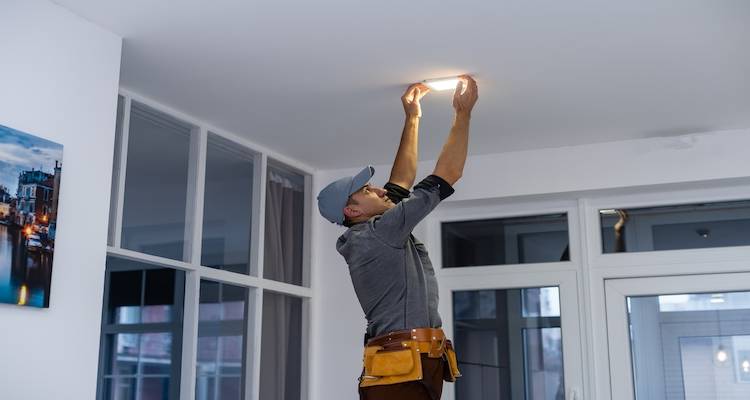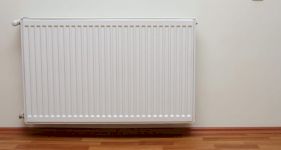Installing Blinds Cost Guide 2025 - How Much is Fitting Blinds?
- The average installing blinds cost is £70.
- The job takes 1 to 3 hours to complete.
- Blind installation costs and types of blind.
- How long the job takes and what is typically involved.
- How to find a local blinds specialist using MyJobQuote.
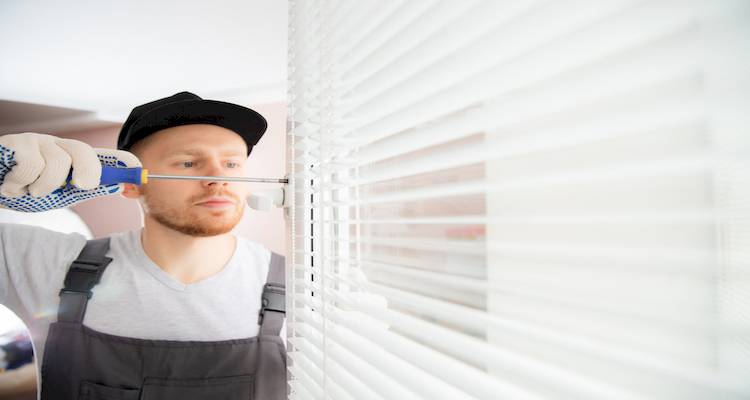
£70
Table of Contents
- How Much Does Installing Blinds Cost?
- Supply Only Costs
- Labour Costs and Timescales
- Cost Factors of Installing Blinds
- Benefits of Professional Blinds Installation
- How To Fit Window Blinds?
- Can I Install Blinds Myself?
- Safety Standards for Installing Blinds
- Types of Blinds
- Blinds Maintenance and Repair
- Hiring Contractors for Installing Blinds Checklist
- FAQs
How Much Does Installing Blinds Cost?
So, what is the cost of installing blinds in a house?
The cost of installing window coverings, including blinds, would depend primarily on the size and type. We’re basing the following prices on blinds with dimensions of about 0.6 metres x 1.6 metres.
For blinds with dimensions of 1.2m x 1.2m, you can expect the cost to be close to twice that of the above prices. Free measuring is a service that ensures the perfect fit for blinds, emphasising the convenience and reliability of having professionals measure for customers. Aside from the size and type of blinds, the cost would be affected by the size and state of the work area and ease of access.
The cost of labour, in particular, would also be impacted by where you live since tradesperson prices differ throughout the UK.
Blinds Prices
| Type of Blinds | Labour Cost | Supply Cost | Supply & Fit Cost |
|---|---|---|---|
| Hardwood Blinds | £20 – £30 | £50 – £110 | £70 – £140 |
| PVC Venetian Blinds | £20 – £30 | £30 – £80 | £50 – £110 |
| Aluminium Venetian Blinds | £20 – £30 | £30 – £80 | £50 – £110 |
| Fabric Blinds | £20 – £30 | £15 – £35 | £35 – £65 |
| Skylight Blinds | £20 – £30 | £40 – £90 | £60 – £120 |
| Faux Wood | £20 – £30 | £25 – £50 | £45 – £80 |
| Roman Blinds | £20 – £30 | £30 – £40 | £50 – £70 |
| Roller Blinds | £20 – £30 | £5 – £15 | £25 – £45 |
| Vertical Blinds | £20 – £30 | £15 – £25 | £35 – £55 |
| Electric Blinds | £20 – £30 | £60 – £140 | £80 – £170 |
| Bamboo | £20 – £30 | £10 – £35 | £30 – £65 |
| Pleated Blinds | £20 – £30 | £10 – £50 | £30 – £80 |
Supply Only Costs
The cost of supplying blinds will probably make up most of your bill. The material costs are separate from the labour expenses. The following price figures would be particularly relevant to know if you want to undertake the DIY work since this would be your approximate overall bill.
Otherwise, the cost of supplies would likely account for somewhere within 30% to 70% of the total.
The Cost of Blind Materials:
- Hardwood Blinds - £50 to £110
- PVC Venetian Blinds - £30 to £80
- Aluminium Venetian Blinds - £30 to £80
- Fabric Blinds - £15 to £35
- Skylight Blinds - £40 to £90
- Faux Wood - £25 to £50
- Roman Blinds - £30 to £40
- Roller Blinds - £5 to £15
- Vertical Blinds - £15 to £25
- Electric Blinds - £60 to £140
- Bamboo - £10 to £35
- Pleated Blinds - £10 to £50
For the same size window, the cost of curtains (nylon material) is typically £70 to £165, while most blinds range from £15 to £140.
Labour Costs and Timescales
The price of labour looks just at the cost of the blind installation work itself when hiring a professional. This excludes the supply cost.
Regardless of the type of blinds being installed, you’d be looking at a labour cost of £20 to £30. Likewise, the price would be in and around this figure for most window sizes. For a particularly large window, however, it may bring the labour cost to around £40 to £60.
The hourly cost of hiring a contractor for a blind installation is approximately £20 to £30 per hour; thus, as you can see, as the average cost infers, the work is likely to take no more than an hour.
Usually, the differences will not be sufficient to bring the cost up to two hours of labour. One labour cost factor that is more influential, though, is your location. More on that in the next section.
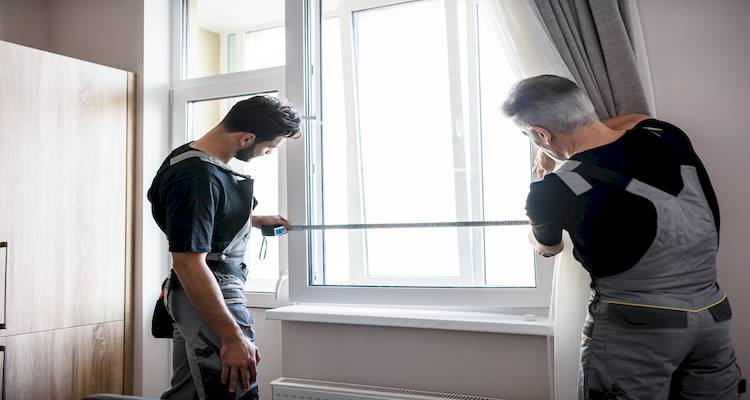
In fact, having blinds installed may take just half an hour for a simpler installation, although a one-hour charge would still probably apply.
The timeframe could vary depending on the size and type of blinds being installed, ease of access to the work area and the type of window you have. Anything that can affect the duration of this work could, in turn, impact the labour cost.
Conservatory blinds, known for their functionality and style, can enhance privacy and light control in different types of spaces.
Cost Factors of Installing Blinds
As mentioned already, various cost factors could shape your overall bill when it comes to blinds prices for a new installation. Let’s have a look at some common examples:
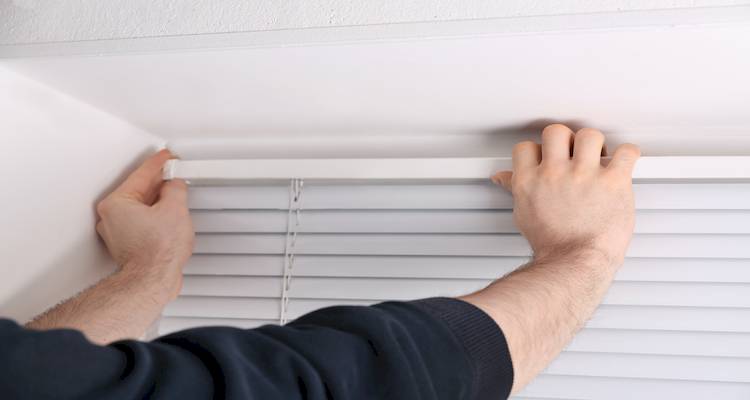
Type of Blinds
Costs can differ greatly depending on the type of blinds fitted. This is mostly down to the materials used, although some may also come with a more expensive design/construction process, which could also play a role in how expensive they are to purchase.
On one end of the scale, vertical blinds cost just £15 to £25, and roller blinds tend to have a supply price of between £5 and £15.
On the other end of the cost spectrum, electric blinds usually cost around £60 to £140 to buy from a retailer. Harwood blinds are also relatively costly. Further, the standalone cost of blinds can vary depending on the brand's quality and product.
Size of the Installation Area
How much an installation area is being covered is also relevant to the total cost. Of course, this could be seen as another way of considering different types of blinds, but instead, it could be seen as looking at the size of the blinds.
Either way, the larger the installation area/blinds, the more it will likely cost. This would primarily affect the supply cost, but there is a small chance it could influence the labour price too.
For example, conservatory blinds would potentially cost more due to the number of windows that need to be covered and the type of blinds you would need to cover a glass roof.
Location of Your Property
Labour prices, in general, differ from region to region. The price of hiring a contractor in northern England would generally be lower than in the southeast. Further, contractor prices in Scotland and Northern Ireland are usually below the national average.
Ease of Access
The easier the installer can access the work area, and in general, the easier the installation is, the quicker it will be. Consequently, a faster instalment process may mean a lower labour bill. Of course, if an accessibility issue slowed down the process by, say, ten minutes, it would probably make no difference.
However, if any additional time pushed the work timeframe past the hour mark, whether by ten minutes or thirty minutes, it could, for instance, bring your bill up to include two hours of labour rather than one.
How do you measure for blinds when your window recess tapers in?
Benefits of Professional Blinds Installation
Fitting blinds can be a daunting task, especially if you’re not familiar with the process. That’s why it’s essential to hire a professional blind installer to ensure a seamless and stress-free experience. With a professional installation, you can enjoy numerous benefits, including:
- Accurate Measurements: A professional installer will take precise measurements of your windows to ensure a perfect fit. This eliminates the guesswork and potential errors that can occur with DIY installations.
- Proper Installation: A professional installer will ensure your blinds are installed correctly, guaranteeing they function smoothly and efficiently. This means no crooked blinds or malfunctioning mechanisms.
- Time-Saving: Let a professional handle the installation, saving you time and effort. You can sit back and relax while the experts do the work.
- Warranty and Guarantee: Reputable installers offer warranties and guarantees on their work, giving you peace of mind. If anything goes wrong, you’re covered.
- Enhanced Safety: Professional installers will ensure that your blinds are installed safely and securely, reducing the risk of accidents. This is particularly important in homes with children or pets.
How To Fit Window Blinds?
The process of fitting window blinds is generally straightforward. However, the exact steps required can differ depending on the method used and the type of blinds being installed, so either way, you should always follow the manufacturer’s instructions. That said, here is one common approach to installing window blinds.
1. Preparation
The first decision is whether or not you want to fit your blinds DIY (we'll discuss this in greater detail in the next section). Let's say you decide to install them yourself, as we imagine you probably intend to.
If you're reading this section, then you'd need to consider what type of blinds you want and what size is needed. After taking the correct measurements, source the blinds you're looking for, but ensure they're suitable for the window you intend to fix them to.
Another consideration before getting to work is whether you want to mount your blinds on the inside of the window’s frame or outside. Above the window frame is another approach, which may or may not also include fitting the blinds to the outside of the window frame.
Most homeowners go with internally mounted blinds for aesthetic and practical reasons. If you find that you have a window frame that is too shallow to add mounting brackets, externally mounted blinds would be a better choice if appropriate.
Lastly, before getting to the installation process, ensure you have the necessary tools and equipment to complete the job.
2. Mounting Marks
The first part of installing blinds on windows is to make the mounting marks. Before doing so, unpack the blinds and ensure all the components are there. For organisational purposes, lay things out in an orderly and spread-out manner.
For an exterior mount, you should put the blind up so that the headrail is level and centred with the window casing. The pencil mark should be made just below the head rail on both sides of the casing. Mark brackets per template, centring headrail and clearing obstructions.
In the case of an interior mount, put the headrail inside the casing. Ensure it is level. The headrail should be level whether or not the window is. Next, establish pencil marks underneath each end of the headrail.
3. Attach the Window Blinds Brackets
To start this step of the job, open the bracket door and hold each of the end brackets in position. Hold them within the pencil marks you’ve made. You'll notice two open sides of the bracket. One should be facing you, whereas the other open side should face the centre of the window. Orient brackets correctly for your design so the headrail clips and locks properly.
Next, make the marks for where you’re going to drill. Mark the spots where the pilot holes will go (two should be required). You want to pick two diagonal holes for drilling into. This would ensure that the brackets are extra secure. Remove the brackets and employ a level to make sure both holes are even.
For attaching the brackets for an outside mount, you should fix the brackets on the exterior face of the window casing on each side of your window. As for an interior mount, you want to place the brackets against the inside top corner on both sides.
Now it's time to drill the holes needed for the screws. Both brackets will come with two or more screws each. The exact process here is going to vary depending on the type of material being drilled into. For wood, drill a pilot hole by matching a drill bit to the screw gauge.
If it is drywall, concrete, stone, tile, brick or plaster you are drilling into, employ suitable screws, plugs or anchors. Follow the instructions given by the manufacturer. You may now replace the window bracket before drilling the screws into position.
4. Fit the Head Rail and Valance
The first phase of this step involves snapping the valance clips into position. The valance clips need to be snapped over the front lip of the head rail. Attach headrail, then add valance clips and valance (unless instructions specify otherwise).
The bracket doors should be wide open at this stage, allowing you to comfortably fit the head rail into them. Once successful, snap the bracket doors shut (this should come with a clear snapping sound – another box ticked).
Now, add the valance. Place it along the head rail based on how you want to position it. Place it atop the valance clips before pressing it down cautiously. The valance clips should snap into the valance upon doing so, holding it in position. Lastly, if the blind wand is not pre-attached, you may now add it per the manufacturer’s instructions.
How can I have blinds installed in my conservatory? Would this be pretty straightforward for a DIYer?
Can I Install Blinds Myself?
As you'd gather, it's perfectly fine to install blinds yourself. Just make sure to follow the manufacturer's instructions, take your time and follow any necessary safety precautions. If in doubt, or if you have a particularly large installation to deal with, it would be best to hire a professional in those cases.
The hazards/dangers to look for when putting up blinds as a DIY installation:
- Hurting yourself while carrying heavy loads.
- Falling if reaching up to a height to hang your blinds.
- Incorrect installation, particularly if not following the instructions correctly.
There are additional safety considerations that must be taken into account, which we’ll now discuss in the following section.
Safety Standards for Installing Blinds
There is a range of safety regulations that must be adhered to when it comes to fitting new window blinds. Of course, much of this will already be covered by the design of the blinds themselves.
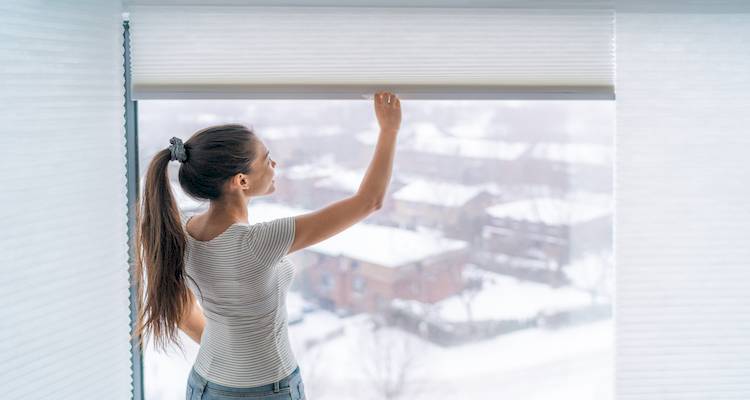
The manufacturer's instructions should naturally take these regulations into account, but it's good to know just in case there are aspects that the installer (particularly if you will fit it DIY) must ensure on their own accord.
The main safety hazard associated with window blinds is the blind chain. Children and animals would be most at risk of becoming accidentally entangled, which could prove very dangerous.
In fact, a study showed that between 1990 and 2015, 271 deaths (mostly children) resulted from blinds, with a further 17,000 injuries/incidents involving children. Blind safety should not be overlooked.
Safety Regulations for Installing a Window Blind:
- The product must be compliant with the child safety requirements related to BS EN 13120:2009+A1:2014 (i.e., source it from a reliable and appropriate supplier).
- The chain/cord safety device has to be fitted at least 1.5m above the floor and as close to the headrail as can be achieved.
- The tensioning device must be a minimum of 1.5m above the floor.
- The breakaway device can be no less than 60cm above the floor.
- Various warning notices must be made available by the supplier, along with other rules to follow.
For more information and diagrams, check out the British Blind & Shutter Association’s surveyor and installer guide for made-to-measure blinds.
Types of Blinds
With so many types of blinds to choose from, it may be difficult to make up your mind. However, in this section, we’ll lay out the features, pros & cons and remind you of the pricing for a range of popular options.
Venetian Blinds
These classic blinds, which arguably had their cultural apex in the noir cinema of the 1940s, remain a popular choice for modern homeowners. Venetian blinds are suspended on ladder cords and feature horizontal slats that are generally made of aluminium, genuine timber or faux wood.
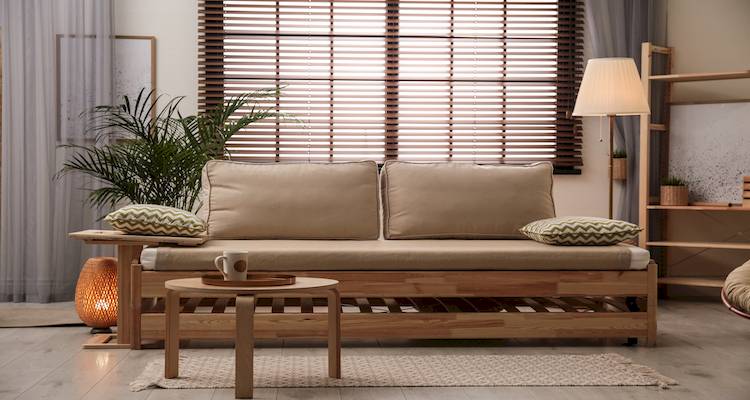
Not only can they be raised or lowered with ease, but they are simpler to adjust by varying amounts such that you have ample control over how much light is being allowed to enter the room. The control mechanism is found in the headrail that sits at the top of the blind.
Installing Venetian blinds means you benefit from control for raising and lowering them and another for tilting the slats. The cost of venetian blinds is usually priced between £30 and £80.
Some of the notable downsides of Venetian blinds is that, unlike other options, they are not 'blackout blinds'. One problem with these is that the fabric used is not well-suited for high-moisture locations like bathrooms or kitchens. If you want Venetian blinds for a bathroom or kitchen, find a non-taped product.
Roller Blinds
Another common selection among homeowners is roller blinds. These are fabric blinds that are available as one or two rollers, depending on what you opt for. Like a large rolled-up sheet of paper, it unfolds, gradually unveiling its full dimensions and cover. You can simply pull the blinds up or down manually to offer the level of cover you'd like.
Pricewise, roller blinds cost £5 to £15, making them the ideal option if you're on a tight budget. Even with the labour price, the cost of roller blinds should come to no more than £45 in most cases, although this would depend on where you live.
There is a very wide range of products available on the market if you're looking for a roller blind, with different designs and colours and various levels of light-blocking strengths ranging from low-level light filtration to blackout blinds. Arguably, the most versatile material for roller blinds would be PVC, which is durable, naturally fire- and water-resistant, and can be wiped with ease.
On the contrary, roller blinds simply do not offer the same degree of light control as Venetian blinds, nor are they particularly energy efficient. In addition, roller blinds have a tendency to warp over time from repeated use.
Roman Blinds
Next, for an especially luxurious option, you should consider Roman blinds. These blinds are made to pleat when raised. The construction of these blinds features slats that are mounted into the back of the fabric panel, all while being hooked up to the relevant cords. When you lift a Roman blind, the cords will pull the slats together, resulting in the blindfolding into pleats.
One point worth noting about installing Roman blinds is that they consist of a thicker fabric than roller blinds. They also feature internally sewn rods for the purpose of ensuring even folds. Roman blinds are offered in a whole host of designs, colours and fabrics. The available linings for these blinds include thermal and blackout.
But it's not all sunshine and roses (or rather the perfectly customised lack of sunshine and roses per your choosing) when it comes to Roman blinds. For starters, with a standalone cost of £30 to £40, they're not the cheapest option and are dearer than, say, roller blinds.
Another notable con of Roman blinds is that they are totally unsuitable for wet environments such as a bathroom or kitchen. If you were to do so, they would eventually develop issues such as grease, mould and odours. This includes Roman blind fabrics that are relatively easy to clean.
Vertical Blinds
Another solution to your home’s light filtration needs would be installing vertical blinds. These are essentially oriented differently, with most blinds being horizontal.
Vertical blinds are pretty much the 'vertical' version of Venetian blinds. In other non-alliterated words, it would be as if you flipped Venetian blinds 90 degrees (with the relevant components such as the cord also flipping 90 degrees).
This means that instead of moving up and down, vertical blinds can be moved from left to right while also coming with a cord allowing you to tilt the slats as you’d like, just like their Venetian counterparts.
The cost to supply vertical blinds is £15 to £25, meaning vertical blinds are one of the least expensive types on the market. They are a good option for full-size doors and windows and, unsurprisingly, come in various designs and colours.
Of course, with larger blinds comes more room for dirt and grease to accumulate, meaning that keeping them clean will be more challenging than with most options.
Also, even setting aside the fact that this would be true for any large blinds, the fact you have to clean each blind vane one at a time distinguishes it from roller blinds where you’d have one single large surface to clean.
Pleated Blinds
Some homeowners may take an interest in pleated blinds in general. In this case, the fabric used for each blind enables the individual blinds to fold open and close as desired.
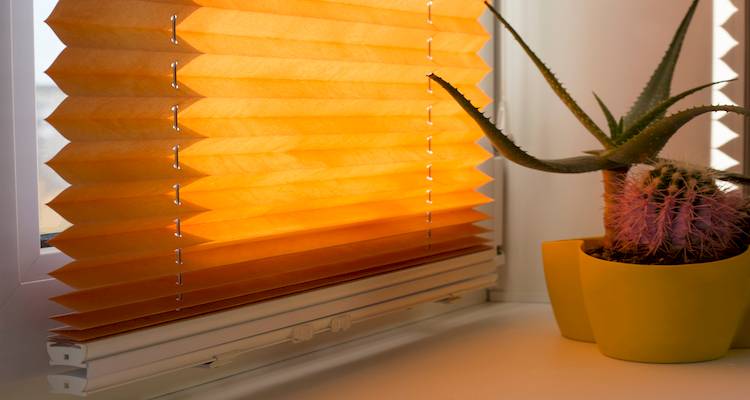
Options include singular pleated fabric, cellular pleated blinds and honeycomb pleated blinds. With an estimated standalone cost of £10 to £50, pricing can vary quite a bit.
One notable benefit is that they typically use a tab instead of a cord for opening and closing. This is generally safer than having a cord, even if all the regulations and safety advice are followed. One issue is that at least certain pleated blinds will not suit any window frame. Therefore, it's important to double-check that a given product is able to be installed on your window frame before making a purchase.
Fabric Blinds
Choosing fabric blinds offers versatility when choosing a new window cover. They can come in a wide range of colours and patterns to suit your decor.
Fabric blinds also give you options of finish from vertical blinds to roller blinds and more. With an estimated standalone cost of £15 to £35, they are a popular cost effective choice.
The choice of fabric is important to consider. Thermal options can help with temperature control. This means that heated rooms stay a bit warmer for longer in winter, while you can also keep a bit more heat out when you're trying to keep the house cool in summer.
Blackout blinds can also help filter light out completely — making them a popular choice for bedrooms.
Skylight Blinds
Skylight blinds are a great choice for anyone with conservatory roof windows, Velux windows or loft skylights.
Installing skylight blinds will not only help control light in rooms that have windows overhead. They can also help regulate temperatures and add an element of privacy. These types of blinds cost between £40 to £90, so they are more expensive than other blinds on the market but are designed for a specific job.
These types of blinds can be made out of a variety of materials including fabric, metal, plastic and wood. When choosing the best material for your skylight blinds, consider the light control needed, if insulation is important, and what style best fits your room.
Bamboo Blinds
Bamboo blinds are a cost effective choice for people looking for a stylish and eco friendly window covering.
They are a much lighter weight than other options, making them easy to install and to maintain. Standard bamboo blinds will block out light glare whilst still allowing for soft, natural light to pass through.
Lined options are available if you require more privacy or insulation.
Blinds Maintenance and Repair
To ensure that your blinds continue to function smoothly and efficiently, regular maintenance is essential. Here are some tips to help you maintain your blinds:
- Dust Regularly: Dust your blinds regularly to prevent dust buildup. Use a soft cloth or a duster to gently remove dust from the slats.
- Clean with a Soft Cloth and Mild Detergent: For a deeper clean, use a soft cloth and mild detergent. Avoid harsh chemicals that can damage the material.
- Avoid Direct Sunlight and Moisture: Prolonged exposure to direct sunlight or moisture can cause your blinds to fade or warp. Keep them in good condition by avoiding these elements.
- Check for Wear and Tear: Regularly inspect your blinds for any signs of wear and tear. Addressing small issues early can prevent more significant problems down the line.
If your blinds are damaged, broken or malfunctioning, our expert fitters are on hand to help repair them without the additional cost of replacement. We offer a range of repair services, including
- Blind Re-stringing: If the strings on your blinds are damaged or broken, we can re-string them to restore functionality.
- Blind Re-tensioning: Over time, blinds can lose their tension. We can re-tension them to ensure they operate smoothly.
- Blind Replacement: If your blinds are beyond repair, we offer replacement services to provide you with new, high-quality blinds.
Hiring Contractors for Installing Blinds Checklist
If you decide you’d rather have a professional install the blinds for you, there are some points you should take into account first.
Checklist for hiring a contractor to fit blinds:
- You may want to source several quotes before deciding*.
- Find out what experience they have.
- Consider their previous work.
- Take a look at any online reviews/ratings they have.
- Asking your friends/family members for recommendations.
- Ask for details of their warrenty and aftercare.
- Ask for their availability and a timeline of completition.
- Ask if they have insurance, to cover unexpected accidents.
*Since the cost of labour for installing blinds is fairly low, it's unlikely that installers in your area will offer significantly different pricing, but you may still want to check in case of any special offers or surprisingly low prices.
FAQs
How do you clean blinds?
If you're willing to take them down, you can put them in a bath with warm water. Of course, you should always check with your manufacturer to ensure your blinds are suitable for either of the cleaning methods described below.
Add several squirts of washing-up liquid to the bath before adding a cup of baking soda. Always be careful when using these sorts of products. You should wear rubber gloves and wash your hands with soap when all is said and done.
Leave the blinds in the bath for an hour before rinsing them down with warm water. Also, make sure to lock the bathroom door while they’re soaking in the bath if you have any curious kids or pets around that could gain access. Wipe away any remaining dirt or dust from the blinds. Once sufficiently dry, put them back in place.
If you'd rather keep the blinds up, you could take the approach of mixing a mild washing-up liquid in a basin of water. Then grab a soft cloth, dip it in the water and wring it out carefully. Go over each slat until they are clean. It's important to ensure not too much water is left at the end of the process as this could lead to water damage.



